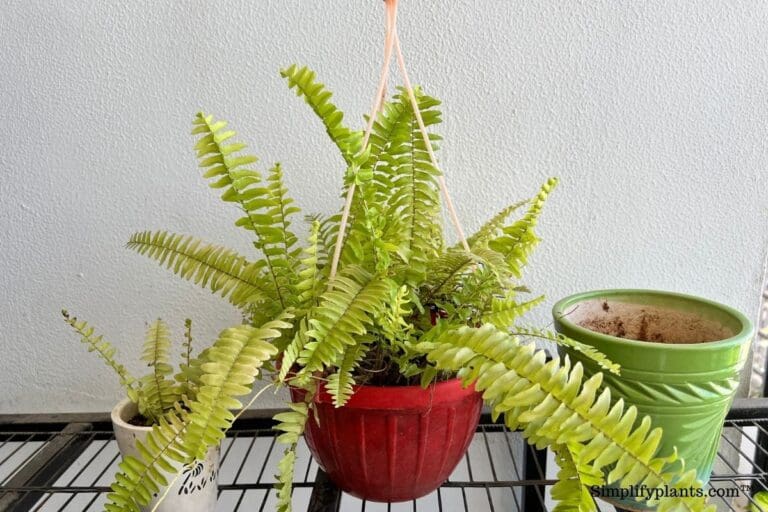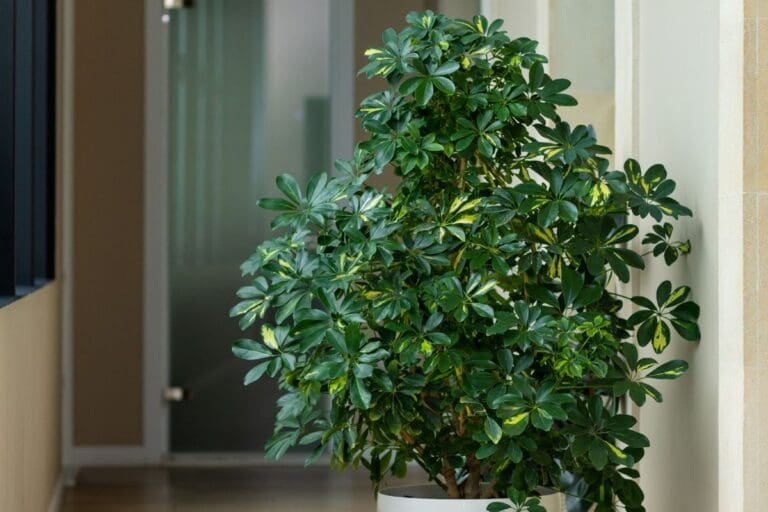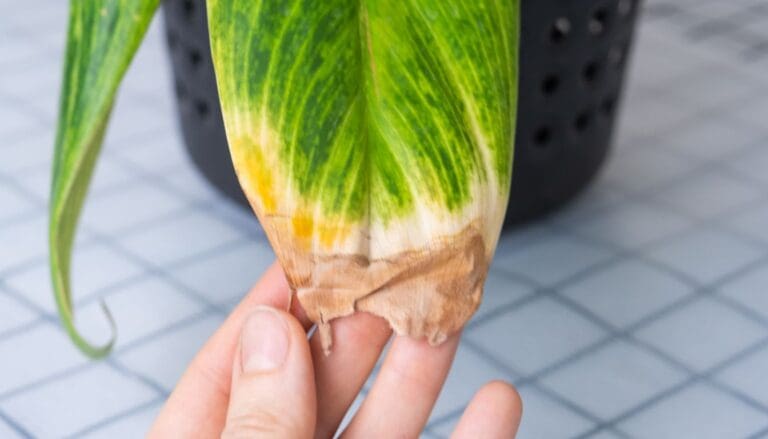Boston Fern Temperature Tolerance: +Ideal Temperature
Boston fern is a popular indoor plant originating from tropical regions. They have bright green leaves and are ideal for improving indoor air quality. But it is important to understand its temperature tolerance to keep it healthy.
In general, Boston ferns prefer temperatures ranging between 60-75°F. It can survive temperatures as low as 50°F, but if you expose it to lower temperatures like 30-35°F, it might wilt. Higher temperatures of 95ºF or above can also result in the drying and browning of leaves.
I will discuss the temperature tolerance of Boston ferns and how to protect them from hot and cold temperatures in this article.

Please note: Simplify Plants is reader-supported. Some links in the post are affiliate links and I get a commission from purchases made through links in the post.
How cold can Boston fern tolerate?
Boston ferns are tropical plants, so they are sensitive to extremely cold temperatures.
Even though these ferns are quite hardy by nature, they cannot bear extremely cold or frosty temperatures.
Because the roots of potted Boston ferns are less protected from the cold than plants in the ground, you must take them inside when night temperatures drop below 45°F, or it will destroy them.
Boston ferns planted in the ground can withstand temperatures as low as 30°F, but the top part will die.
You have to take more care of your Boston fern during wintertime and keep it from experiencing extremely cold temperatures.
Can I put my Boston fern outside?
Although Boston fern is commonly grown as a houseplant, it thrives outside USDA zones 9 to 11.
The fern may get killed by frost, but it will recover in the spring.
In gardens, Boston ferns prefer partial to full shade or filtered light.
This makes it an excellent choice for shaded spots, as it adds a splash of vibrant color where few other plants can thrive.
Outside, Boston ferns require a lot of water.
Provide enough water to keep the soil moist, but never let it become soggy or waterlogged.
Spray the plant softly on hot days if you reside in a dry climate.
If your Boston fern is in a container outside, it will most likely need to be watered every day during the summer.
Keep an eye on the plant at all times.
On warmer days, the fern may need to be watered again.

When should I bring my Boston fern inside?
You should place your Boston fern indoors during the winter before the season’s first frost as these ferns cannot bear extreme cold and will die.
Boston ferns require just as much shelter from extreme heat as from extreme cold.
Under deep tropical canopies, wild Boston ferns thrive on the forest floor.
The regions where Boston ferns grow are cold because the trees obscure the light.
Temperatures of no more than 75°F during the day and 65°F at night are ideal for their growth.
Temperatures of 95°F or higher can kill a Boston fern.
They should be placed outside in a shady area where the temperature does not get this high.
What is the ideal temperature for Boston fern?
The ideal temperatures for Boston ferns are between 60°F and 75°F, but they can tolerate temperatures as low as 50°F.
Avoid keeping them under direct sunlight as continuous high temperatures are also detrimental to their overall health.
You should keep them away from frost during winters, or they will die unable to bear such low temperatures.
Effects of low temperature on Boston fern

If you keep your Boston fern below 60°F, it will start showing the following signs:
- Yellowing of the leaves
- Dry crumbly leaves
- Weak growth
- Brown spots on leaves
- Stunted growth
Low temperature negatively affects tropical ferns, don’t be careless with the plant if it starts showing such signs.
You can follow the steps given below to revive your Boston fern from a cold shock:
- Bring your Boston fern to room temperature: If the temperature drops below 40°F, bring your Boston fern indoors as soon as possible. Colder temperatures can kill or seriously harm the plant.
- Remove any dead foliage: Look for any foliage that has died. Dead leaves will turn a deep brown or black color. Cut off all dead fronds with pruning shears or scissors. Work your way up the plant from the bottom to the top.
- Keep it in a humid atmosphere: Place the Boston fern in a shallow tray with water and a layer of rocks. Water should be kept below the pebbles and not in contact with the container. Or place a humidifier near the plant or sprinkle the plant’s remaining leaves daily. Your plant’s leaves will turn brown if it doesn’t get enough water.
- Water lightly: Thoroughly water the Boston fern until the soil is moist. Before watering again, let the soil dry out a little. Overwatering might cause the fronds to turn yellow.
- Wait till it has recovered before adding fertilizer: Stop fertilizing the fern until it is safe to bring it outside with no risk of frost. Start giving it half the recommended amount of liquid houseplant fertilizer when you’re ready to transfer the fern outside.
Effects of high temperature on Boston ferns

You should keep your Boston fern away from direct sunlight and heaters so that it does not dry up.
Like extreme low temperatures, extremely high temperatures can also kill it.
If your Boston ferns suffer from high heat and low humidity, you will notice the following signs:
- Leaves will wilt
- Leaf edges will become brown.
- Scorched leaves
- Soil dries up
- Foliage loses its green color.
It’s necessary to imitate the humid circumstances of the Boston fern’s native environment by producing a humid micro-climate around the fern in your home to revive ferns with browning and drying leaves.
The following steps will help you to revive your dying Boston fern:
- Increase humidity: Put your fern in an area with greater humidity, such as a bathroom or kitchen. The air in the bathroom is humid, which lowers water loss and keeps the leaves from drying up. Use a humidifier or group the Boston fern with other humidity-loving plants.
- Keep the soil moist but not saturated: Add compost with plenty of organic matter to the soil and water to keep the soil evenly moist. If the leaves turn brown and the earth feels wet, you’re probably drowning your fern.
- Keep it out of direct sunlight: The beauty of ferns is that they can grow even in shaded areas. So, choose a location in your home where they won’t be exposed to direct sunlight, which would scorch the leaves and dry out the soil, resulting in brown foliage.
- Water with lukewarm water: Most indoor ferns are tropical plants, so watering them with lukewarm water mimics their natural environment. If the water is cold, it might cause shock to their sensitive roots, causing the leaves to turn brown.
- Keep it away from AC and heaters: Heaters and AC cause temperature fluctuation for Boston ferns, causing plants to turn brown as a symptom of stress.
Can Boston fern survive winter?
The most important thing to keep in mind is to prevent these plants from getting frostbite during winters.
Choose a proper location for your fern place it indoors somewhere it is cool and humid.
During the daytime, make sure that it receives plenty of indirect sunlight.
You can provide care to the Boston fern by keeping them indoors or allowing them to go dormant and live in a shaded area during winter.
But before that, you have to make sure that your fern is ready for the winter by following the steps given below:
- Prune the old leaves keeping only the new ones. This will prevent the fern from catching any diseases after being moved indoors.
- Do not relocate the plant to a new location suddenly. Gradually acclimate it to its new surroundings.
- When overwintering Boston ferns, don’t fertilize them.
- When new branches emerge from the soil, resume regular feeding and watering.
How to take care of the Boston fern in the summer and winter?

| Factor | Summer Care | Winter Care |
|---|---|---|
| Light | Keep your Boston fern away from a bright window or cover it with curtains to keep it out of direct sunlight. | Place the fern under a shady area and let it get direct sunlight for 1-2 hours every day. |
| Water | Water your fern weekly or even more frequently during the hot summer days. Check the soil’s moisture. | Keep the soil moist by watering the ferns twice a week. If your fern is dormant, you should only water it once a month after checking the soil with a moisture meter. |
| Fertilizer | Add fertilizer once a month during summer. A water-soluble fertilizer diluted at half strength is the best Boston fern fertilizer in the summer. The NPK ratio of the fertilizer should be 20-10-20. | Avoid fertilizing in winter. |
| Repotting | The best time to repot Boston ferns is during the summer-springtime when they have a healthy growth rate. | Try to avoid repotting during winter if not required urgently. |
| Placement | Keep it in a shady area or away from the direct sunlight, with much light humidity and temperatures. | If the temperature is very low, keep the fern inside away from air heaters, in the kitchen, or near the bathroom where it’s more humid. |
| Humidity | You can use a humidifier or sprinkle water frequently to keep it from drying. | Use humidifiers and keep them away from heaters. |
Can Boston fern survive in air-conditioned rooms?
The short answer to this is, yes, it can survive in air-conditioned rooms.
You have to keep it far away from the AC so that direct drying air does not reach the Boston fern.
Also, make sure to use a humidifier to keep it aptly hydrated, and there will be no problem with it growing in an AC room.
Final thoughts
Boston ferns are tropical plants that thrive in hot, humid climates. You can grow them outside during the spring and summer, but they can only thrive indoors when conditions become harsh.
Whether indoors or out, Boston ferns prefer a cold, humid climate with indirect light. However, they can handle bright light better than most ferns.
The Boston fern prefers normal temperatures: neither too hot nor too cold. Boston ferns thrive between 60-75°F. Try to maintain the temperatures to avoid causing stress to the plant.
Reference: University of Florida, The University of Arkansas Division, Texas A&M University System, The University of Georgia, University of New Hampshire, Wikipedia, The Royal Horticultural Society.
Recommended Garden Supplies
| Product Image | Our Recommended Gardening Supplies | Check Offers! |
|---|---|---|
Top Top
Top
Top
Top
Top
Top
Top
Top | rePotme Houseplant and Tropical Classic Potting Soil Mix | Check Offer On Amazon |
 Top
Top
Top
Top
Top
Top
Top
Top | Espoma Organic Indoor Plant Food | Check Offer On Amazon |
 Top
Top
Top
Top
Top
Top
Top
Top | GooingTop LED Grow Light 6000K Full Spectrum Clip Plant Growing Lamp | Check Offer On Amazon |
 Top
Top
Top
Top
Top
Top
Top
Top | Soil Moisture Meter | Check Offer On Amazon |
 Top
Top
Top
Top
Top
Top
Top
Top | Govee Hygrometer Thermometer, Bluetooth Enabled! | Check Offer On Amazon |
 Top
Top | LEVOIT Humidifiers for Large Room(Best For Plants) | Check Offer On Amazon |
 Top
Top
Top
Top
Top
Top
Top
Top | Upgraded DIY Automatic Drip Irrigation Kit, 15 Potted Houseplants Support | Check Offer On Amazon |
 Top
Top
Top
Top
Top
Top
Top
Top | Stainless Steel Heavy Duty Gardening Tool Set | Check Offer On Amazon |
 Top
Top
Top
Top
Top
Top
Top
Top | Bonide Insecticidal Soap | Check Offer On Amazon |
 Top
Top
Top
Top
Top
Top
Top
Top | Bonide 32 oz Spray Neem Oil for Organic Gardening | Check Offer On Amazon |
 Top
Top
Top
Top
Top
Top
Top
Top | Garden Safe Fungicide | Check Offer On Amazon |







Excellent article.
Thank you